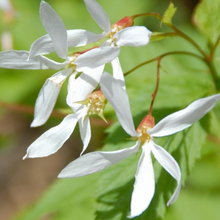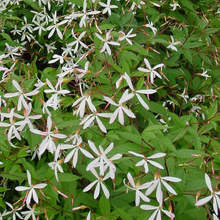Porteranthus trifoliatus is a distinctive native perennial with trifoliate leaves and wiry upright stems topped by delicate star shaped white flowers. Blooming in early summer, its airy structure adds fine texture to woodland edges and naturalized plantings. As the season progresses its foliage turns bronze to burgundy providing ornamental value well into fall. It belongs to the rose family and is closely related to Spiraea and Filipendula.
Height & Spread: 24 - 36 in x 18 - 24 in
Bloom Time: Late spring to early summer
Light Requirements: Part shade to full sun
Soil Preference: Moist, well drained to average soils
Watering Needs: Moderate; tolerates some drought once established
Deer Resistance: Moderately deer resistant
Native Status
This species is native to the eastern United States, found in open woods, rocky slopes, and upland forests where it grows in dappled light and well drained soils.
WILDLIFE & INSECTS
Butterflies
- Visited by butterflies such as Eastern Tiger Swallowtail and Great Spangled Fritillary for its accessible summer nectar.
Bees
- Supports a wide range of native bees including sweat bees, mining bees, and small carpenter bees during peak bloom.
Moths
- Serves as a nectar source for day flying moths such as Virginia Ctenucha and Hummingbird Clearwing.
Beneficial Insects
- Attracts hoverflies and parasitic wasps that contribute to pest control and pollination in native plant gardens.
Spacing & Landscape Use
Spacing Recommendations:
- Space 18 - 24 in apart to allow for upright clump development and to showcase its airy floral display.
Landscape Placement:
- Effective in woodland edges, shaded pollinator gardens, or as an accent in native perennial beds where its texture contrasts bolder foliage.
Companion Plants
- Phlox divaricata (Wild Blue Phlox) - Spring blooming shade perennial that softens the base of Porteranthus with a carpet of fragrant blue flowers.
- Carex pensylvanica (Pennsylvania Sedge) - A fine textured native sedge that complements the upright stems and thrives in similar light and soil.
- Aruncus dioicus (Goats Beard) - A bold tall perennial that echoes the airy floral form on a larger scale for layered woodland planting.
- Solidago caesia (Wreath Goldenrod) - A fall blooming native that thrives in woodland shade and extends the garden’s seasonal interest.
- Geranium maculatum (Wild Geranium) - Offers mounded foliage and soft pink flowers earlier in the season complementing Porteranthus’s later bloom.



